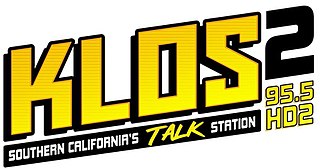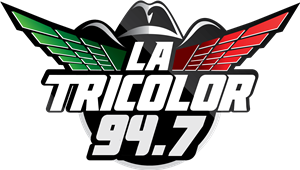Related Research Articles

KLOS is a commercial radio station that is licensed to Los Angeles, California, and serves the Greater Los Angeles area. The station is owned by Meruelo Media. KLOS airs a mainstream rock radio format and has broadcast rock music in some form since 1969. The studios are on West Olive Avenue in Burbank.

KDLD is a commercial FM radio station in Santa Monica, California, broadcasting to the Greater Los Angeles area on 103.1 MHz. KDLE is a commercial FM radio station in Newport Beach, California, broadcasting to the Orange County area on 103.1 MHz.

KKLQ is a non-commercial FM radio station owned by Educational Media Foundation (EMF) and carries the contemporary Christian music format of its nationally syndicated network K-Love throughout the Greater Los Angeles area. Licensed to Los Angeles, California, KKLQ's transmitter is located atop Mount Wilson and has a booster in Santa Clarita, KKLQ-FM2 at 100.3 MHz, to extend its coverage into the Santa Clarita Valley and other areas north of Los Angeles.
KTWV is a commercial radio station licensed to Los Angeles, California, and broadcasting to the Greater Los Angeles area. The station is owned by Audacy, Inc., and airs an urban adult contemporary radio format. KTWV has studios on Wilshire Boulevard in the Miracle Mile district of Los Angeles. As "94.7 The Wave," the station was known for pioneering the smooth jazz radio format in the late 1980s.

KYSR is a commercial radio station licensed to Los Angeles, California, and owned by iHeartMedia KYSR broadcasts an alternative rock format and is the flagship station of syndicated morning drive time program The Woody Show. The KYSR studios are on West Olive Avenue in Burbank.
KSOL is a Spanish language radio station in San Francisco, California. KSQL simulcasts the station in Santa Cruz. KSOL and KSQL program a format consisting of regional Mexican music and talk shows. Both stations are owned by TelevisaUnivision USA. Its studios are located at 1940 Zanker Road in San Jose, and the KSOL transmitter is on Mount Sutro.

KKGO is a commercial radio station licensed to Los Angeles, California. It is owned by Mount Wilson FM Broadcasters and airs a country music format, switching to Christmas music from Thanksgiving weekend to Christmas Day. The studios are on Cotner Avenue at Ohio Avenue in Los Angeles' Westwood neighborhood, while the transmitter is atop Mount Wilson. Besides a standard analog transmission, KKGO broadcasts four HD Radio channels and is available online.
XESURF-AM is a Mexican radio station licensed to Tijuana, Baja California, serving the San Diego–Tijuana metropolitan area. XESURF airs a Spanish-language Christian radio format. It is operated by Zion Multimedia Inc. located in Downey, California.
KEBN 94.3 FM, Garden Grove, California, KBUE 105.5 FM, Long Beach, California and KBUA 94.3 FM, San Fernando, California are a trimulcast comprising Que Buena 105.5/94.3 FM, a Spanish language regional Mexican music station owned by Estrella Media.
KBUA 94.3 FM, San Fernando, California, KBUE 105.5 FM, Long Beach, California, and KEBN 94.3 FM, Garden Grove, California, are a trimulcast comprising Que Buena 105.5/94.3 FM, a Spanish language regional Mexican music station owned by Estrella Media.

KLNV is a Regional Mexican radio station broadcasting to the San Diego metropolitan area. It is owned by TelevisaUnivision, and is a part of the Uforia Audio Network. Studios are located on West Broadway in San Diego, with its antenna located near 60th Street and Tooley Street in San Diego's Emerald Hills neighborhood, and is co-located with KWFN and KOGO.
KWIZ is a commercial radio station licensed to Santa Ana, California, and broadcasting to the Los Angeles-Orange County area. KWIZ airs a Spanish Christian radio format branded as "Vision Latina 96.7 FM". It is currently owned by the Universal Church with studios and offices are on West 5th Street in Santa Ana. The transmitter is off East Glen Albyn Lane in Orange, California.

KYSE is a commercial radio station in El Paso, Texas. It airs the "La Tricolor" Regional Mexican radio format from its owner, Entravision Communications. The studio and offices are located on North Mesa Street in northwest El Paso.
KRQB is one of four Southern California radio stations branded as "Que Buena" and which all play Regional Mexican music. Its owner is Estrella Media. KRQB shares the same weekday morning show as the three Los Angeles-area Que Buena stations, but has local DJs the rest of the day. KRQB is licensed to San Jacinto, California, and serves the Riverside-San Bernardino radio market.
The year 1994 in radio involved some significant events.
The year 1995 saw a number of significant events in radio broadcasting.
KMZT is a commercial radio station licensed to Beverly Hills, California. Owned by Mount Wilson FM Broadcasters, the station serves Greater Los Angeles and much of surrounding Southern California. The KMZT studios are located in Los Angeles' Westwood neighborhood, while the station transmitter resides in the nearby Mission Hills neighborhood. Besides a standard analog transmission, KMZT broadcasts over through the HD Radio in-band on-channel standard for AM stations, is simulcast on low-power Los Angeles translator K252FO and the second HD digital subchannel of KKGO, and is available online.
KQBU-FM is a commercial radio station broadcasting a Spanish language sports radio format, simulcast on KLAT in Houston. KQBU-FM is licensed to Port Arthur, Texas, and primarily serves the Houston-Beaumont-Port Arthur area. It is owned by the Uforia Audio Network and carries programming from the co-owned TUDN Radio Network. The station airs Spanish-language broadcasts of the Houston Astros baseball team, the Houston Rockets basketball team, and the Houston Dynamo FC MLS soccer team.
KJOJ-FM was a radio station licensed to Freeport, Texas, United States, operating as a rimshot into the Greater Houston area. It was last owned by Estrella Media and operated in tandem with KTJM in Port Arthur, with its transmitter to the east of the Houston area. The KJOJ-FM transmitter was located off Sgt. Joe Parks Memorial Highway in Sargent, Texas; studios were in Bay City.

KROQ-FM is a commercial radio station licensed to Pasadena, California, serving the Greater Los Angeles. Owned by Audacy, Inc., it broadcasts an alternative rock format known as "The World Famous KROQ".
References
- ↑ "Call Sign History" . Retrieved January 12, 2011.
- ↑ "Facility Technical Data for KBUE". Licensing and Management System. Federal Communications Commission.
- ↑ Radio-Locator.com/WBUE
- 1 2 3 4 5 FCC History Cards for KBUE
- ↑ Broadcasting Yearbook 1965 page B-16
- ↑ Gelb, Jeff (September 19, 1980). "AOR Experiments With New Wave Format" (PDF). Radio & Records. pp. 43, 44. Retrieved September 26, 2021.
- ↑ "KNAC's Final Fade to Black". Los Angeles Times . Retrieved November 6, 2012.
- ↑ "KNAC A to Z". Archived from the original on June 7, 2000. Retrieved August 31, 2013.
{{cite web}}: CS1 maint: bot: original URL status unknown (link) - ↑ "The Last KNAC Article". Archived from the original on August 15, 1997. Retrieved November 9, 2016.
{{cite web}}: CS1 maint: bot: original URL status unknown (link) - ↑ "www.knac.com – Pure Rock On The 'Net – Look Out World, KNAC Is Coming For Ya!". vogelism.com. March 27, 1998. Retrieved March 14, 2016.
- ↑ "KNAC to return?". metalnewz.com. January 31, 2016. Archived from the original on March 14, 2016. Retrieved March 14, 2016.
- ↑ Broadcasting & Cable Yearbook 1996 page B-44
- ↑ Stark, Phyllis (March 18, 1995). "Vox Jox". Billboard . Vol. 107, no. 11. p. 78.
- ↑ "KIK-FM (now KMXN) 94.3 MHz, Garden Grove (Anaheim), CA